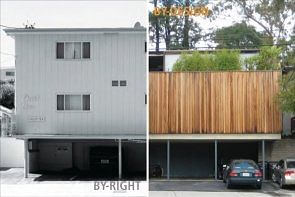
Architects Alice Kimm, FAIA; John Mutlow, FAIA; Lorcan O’Herihy, FAIA; Warren Techentin, AIA; Patrick Tighe, FAIA; and Ed Woll, Ph.D. will present housing projects in development and discuss the potential of micro-housing units, transit oriented development and changing lifestyles to create livable density in LA. — USC Architecture
This past Wednesday, I attended a panel discussion of architects at the University of Southern California about the future of housing in Los Angeles -- an exciting and highly debatable topic nowadays, as transit networks expand and neighborhoods densify. Presented in conjunction with two recently-concluded coordinated exhibitions originally sponsored by LA Forum for Architecture and Urban Design, "BY-Right/BY-Design" and "How Small Is Too Small?", the discussion was a type of send-off by trying to describe what smaller and more efficient housing in Los Angeles may look like in the next twenty years. While it didn't really provide any tangible answers to that prompt, the panel did settle on a necessary focus of residential architecture: empathizing with the specific inhabitant.

Given population growth within the past twenty years, housing is certainly a top priority for developers: since 1990, LA County as a whole has risen from approximately 8.9M to 10M*, and accommodating that population usually falls in the hands of developers. And if building smaller units is the humane and cost-effective way to go, then some cities within LA County are more hospitable than others in terms of regulations and permits. Fears persist that downtown arts-district apartments will go the way of the Bowery if they were developed as micro-units, while Santa Monica recently completed a complex of micro-apartments (at a luxurious 375 sq ft) in its downtown.

Discussions of micro-units have emerged recently on both coasts: at the end of 2012, San Francisco approved 220 sq ft apartments, making the 375 sq ft plans on display at "How Small Is Too Small?" look positively baronial, while the "Making Room" exhibition in New York City recently showcased designs for 325 sq ft living spaces (a size that isn't allowed in most of the city). But when building for smaller spaces, the design rules don't simply shrink proportionally -- they change, and so must the inhabitant's mindset.

Aside from reiterating some basic tenets of efficiency and design for smaller spaces, like creating multi-tasking areas and reevaluating cultural expectations (Americans love huge bathrooms), the panel did not offer any drastic insight into the difficulties of designing for a changing housing market. But it did reiterate that the audience, mostly USC architecture students, should regard social advocacy as inseparable from design. There's no such thing as "too small", because one client's needs will differ from the next.
*source: Dr. Housing Bubble.
2 Comments
I grew up in NYC.and we were very fortunate we had a 8'x5'+/- bathroom. This included a WC, sink, tub and stall shower the LA idea of bathrooms being practically a bedroom in crazy. Spaces should reflect the function & how many hours does one need to spend in a bathroom??
Kevin, I have the feeling that the bathrooms shown here reflect ADA requirements. It would be nice though, in these scenarios, if the valuable SF could be used elsewhere for space that is occupied for longer duration. ADA requirements are extremely cumbersome in many cases.
Block this user
Are you sure you want to block this user and hide all related comments throughout the site?
Archinect
This is your first comment on Archinect. Your comment will be visible once approved.